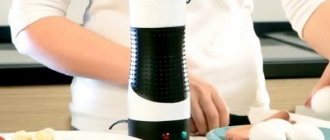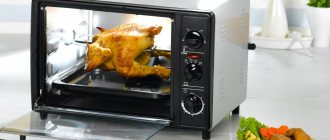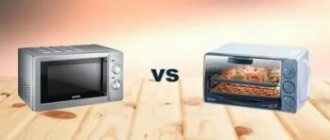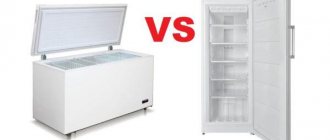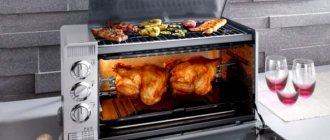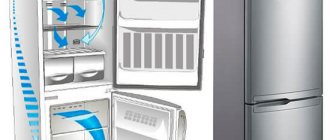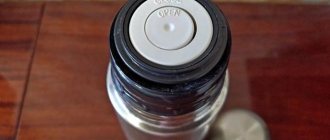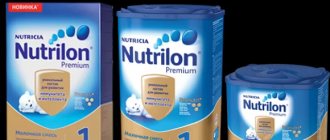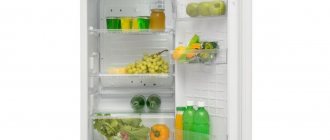The principle of operation of ice cream makers
A cooled container with blades is filled with a ready-made mixture of milk, cream, sugar and other fillers. The device is then connected to the mains. The blades begin to rotate and mix the sweet milk mixture, which cools from contact with the cold walls of the container. As a result, the whipped mixture hardens and mixes evenly, forming ice cream of the same thickness. The quality of ice cream depends on the consistency of mixing and uniform cooling of the mixture. If these two conditions are not met in sufficient interconnection, ice crystals will appear in the mass. They will crunch unpleasantly on your teeth.
Mechanical
The simplest in design are mechanical ice cream makers.
The mass is mixed by periodically turning the blades manually using a special handle. This operation should be repeated every two or three minutes. The bowl is made with double walls. A mixture of coarse salt and fine ice is poured between them, which over time turns into a cold brine solution. The lifespan of this cooler is short. It has to be frozen in the freezer for each new serving of ice cream. This primitive “refrigerator” cools the inner wall of the bowl. Using a mechanical ice cream maker, you can make ice cream without electricity.
Electric: automatic and semi-automatic
Modern household electric ice cream makers are available in two versions:
- Desktop autonomous model of semi-automatic type. The walls of the bowl of such devices are double. The space between them is filled with refrigerant. It is capable of storing cold. To do this, place the bowl in the freezer for 10–15 hours. This supply of cold is enough to prepare one batch.
Semi-automatic ice cream maker HILTON requires constant replenishment of ice
- Compact model of a compressor-type freezer. Continuous and uniform cooling of the bowl walls occurs due to a special cooler (freon), the constant circulation of which is carried out by a compressor. This type of ice cream maker uses the heat pump principle. These models are designed for continuous operation over a long period of time.
Automatic ice cream maker VIS-1599A is compact and can work for a long time
Operating principle and types of ice cream makers
All models of ice cream making machines are divided into three types according to the principle of operation.
- Manual models will require some manipulation, but they are capable of making ice cream without connecting the device to the mains, therefore, they do not depend on outlets. Structurally, the device consists of a bowl and a mechanical mixer for mixing the contents. The container of the ice cream maker has double walls, into which the coolant is poured - crushed ice and coarse salt. Turn the mixer blades every 2 to 3 minutes until completely cooked.
- Semi-automatic ones have earned their popularity for two reasons: affordable cost plus minimal manual intervention. The device is a design similar to a manual one: a paddle mixer and a container with double walls into which the refrigerant is poured. The bowl for the ice cream product is first placed in the freezer for 12-15 hours - this is the only intervention in the process, the rest will be done by the equipment.
- Automatic ice cream makers are designed to last for a long time. Cooling is achieved by freon circulating under the influence of a compressor. A fully automated household appliance will make a finished dessert in about half an hour.
Thus, even the simplest manual model will greatly facilitate the process of making high-quality ice cream. Using any of the above machines is quite simple even for an inexperienced housewife or owner. In addition, the automated process significantly reduces cooking time, which will be an undeniable advantage for a modern person; today, time is money.
Brief general instructions
- Having chosen a recipe for making ice cream, prepare, mix and cool the mixture of ingredients in advance to a temperature of plus 6–8 degrees (in the refrigerator compartment).
- Add small doses of alcohol to the milk mixture to speed up the cooling process.
- Do not fill the bowl more than half the volume, as during the process of mixing the mass, its quantity will almost double due to saturation with air.
- Prepare the fruit puree while the ice cream maker is running, as it can only be added at the very end of the cooking process.
- Adjust the operating modes of the ice cream maker strictly according to the manufacturer's instructions.
- Ready ice cream can only be unloaded from the bowl using wooden or plastic spoons.
- Do not leave the ice cream maker plugged in after finishing the ice cream making process. As soon as the milk mixture reaches the required thickness, the device should be disconnected from the electricity, and the finished ice cream should be unloaded into pre-prepared containers.
First experience making ice cream
First, master the basic recipes, then improve and experiment. This useful home appliance allows you to make absolutely any dessert, including without sugar. So, what does a simple basic recipe for classic ice cream “Plombir” look like:
- Milk and cream of any fat content are used as a basis - 300 ml;
- four yolks;
- granulated sugar – 100 g;
- vanilla sugar – 2 tsp.
First, add cream to the milk and bring to a boil over low heat. Mix the yolks and sugar well and beat until the mixture is white and has a uniform consistency. Gently combine the milk and egg mixtures, then whisk again. The resulting ice cream mass must be heated over a fire, grinding the grains, but not brought to a boil. Cool the finished mixture to a temperature below 10°, add vanilla sugar. The result is a homemade ice cream base that you can pour into your ice cream maker.
Most recipes for making ice cream in an ice cream maker are based on a basic “ice cream”, then the creative and taste boundaries are not limited in any way . If your “assistant” comes with a recipe book, be sure to study it; often many recipes are developed specifically for a specific model.
How to avoid possible problems
To make ice cream at home tasty and healthy, you need to meet a number of conditions:
- Use only natural products, fresh and high quality. This applies to dairy products, fruits and berries, chocolate, cocoa, honey. It is best to use natural vanilla bean as a flavoring.
- Before use, be sure to cool the bowl of the ice cream maker in the freezer (for manual and semi-automatic models).
- When heating milk and fruit mixtures, never bring them to a boil (maximum heating temperature plus 80 degrees).
- Flavorings are added to the cooled mixture, but not to the hot mixture.
- Pieces of nuts, fruits, and chocolate must first be kept in the refrigerator and added to the almost finished ice cream.
- Adding small doses of liqueur, rum, or cognac can influence not only the special taste of ice cream, but also make it tender, airy, and soft.
How to make ice cream or ice cream recipes for an ice cream maker
Do you remember the taste of the ice cream sundae that you bought for yourself so often as a child? A few kopecks - but so much joy! Creamy, viscous, with a vanilla aroma - it seems to me that the taste of that ice cream is impossible to forget! However, this is not a reason to be discouraged - I can offer you proven ice cream recipes for an ice cream maker, including instructions on how to make ice cream at home.
They say that ice cream sundae appeared in France during the time of Napoleon - in the small town of Plombiere-les-Bains they came up with a frozen dessert made from heavy cream, milk and eggs. Having received the name from the name of the city from which it came, the ice cream quickly spread across Europe and in record time became a fairly popular type of ice cream.
Important: do not forget to properly cool the ice cream bowl before you start making ice cream at home - I just store it in the freezer, so by the time I need it, it is always cooled to maximum. If you do not have the opportunity to constantly keep the bowl of the ice cream maker in the freezer, place it there 10 hours before the time you plan to prepare the ice cream.
Ingredients:
150 g of heavy cream (fat content - at least 33%, it is better to buy country milk);
100 ml fat milk;
3 squirrels;
1 cup of sugar;
vanilla.
Place the cream in a saucepan - the fattier it is, the tastier the ice cream will be.
Pour milk, add a third of a glass of sugar.
We put it on the fire and, without bringing it to a boil, wait for the sugar to dissolve - the mass should become completely homogeneous. Put it in the freezer.
Pour the remaining sugar into a bowl and add vanilla.
Add whites.
Turn on the mixer.
And beat until you get a thick, dense mass.
We take the well-chilled creamy milk mass out of the freezer and pour it into the protein mass.
Stir until smooth.
We take out the bowl of the ice cream maker from the freezer, install the lid and, turning it on, begin to slowly pour in the resulting mass. If you are lazy and immediately put the entire future ice cream in the bowl and only then turn on the ice cream maker, the mass in the bowl will “come together” in lumps, stick to the walls and turn into an incomprehensible something. Don't be lazy - do as required.
In the bowl of the ice cream maker, the mass cools for about 25-30 minutes. This time I didn’t have time, I had to run away urgently - I had to turn off the ice cream maker 20 minutes after it started working. In principle, and this is quite enough, however, you could hold the ice cream for another 5-10 minutes - then the mass would become almost completely dense and almost ready to be formed into balls and served.
Transfer the mixture to a food container and cover with a lid.
Place in the freezer for at least 3 hours.
Bon appetit!
Other interesting articles in this section
Chocolate ice cream cake
Desserts with halva
Baking and desserts - proven ideas and step-by-step instructions
